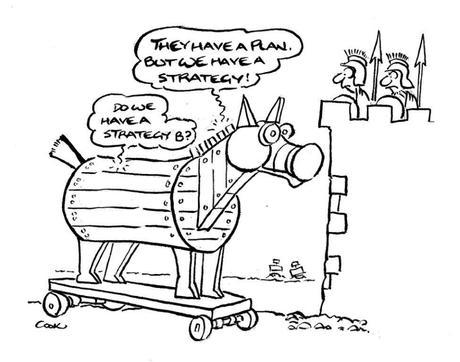
 Planning Vs. The Plan
Planning Vs. The Plan
There’s a lot to be said for strategic plans. Maybe too much. I Googled them a few moments ago and got 128 million results.
Strategic plans are a useful road map. We like to know where we are going and there’s nothing wrong with a target. But are they essential?
I wasn’t in the garage when the first Macintosh was built (by Steve Wozniak, btw, not by Jobs) but from what I’ve read, the two Steves didn’t map out Apple’s strategy on the back wall. They just got on with it.
In photographs of that garage, you can’t even see a whiteboard. (I mean really, what were they thinking?)

iSelect started out with Damien Waller building a site for pension fund management before opting for the successful comparison site. That shift is often attributed not to Waller but to now-departed co-founder, David Urpani.
So there’s a trend here. None of them did it alone, nobody started with a plan, and even if they did, they ended up with something that didn’t look anything like what they started with.
Does that mean we should skip strategic planning?
Maybe. These examples are about entrepreneurs – people working with a clean canvas. It’s a lot easier to go after a great idea when you don’t have to deal with a lot of existing stuff.
So is strategic planning more important when your business is already established?
The evidence isn’t that great.

Royal Bank of Scotland ran quite a nice bank from 1727 until the current millennium, when it implemented an aggressive plan to expand globally. When RBS collapsed in 2008, it was only saved by a taxpayer bailout.
Billabong was a great fashion brand that pretty much owned the surfwear niche until a growth strategy took its product into distinctly un-cool outlets in far too many places.
It’s a common headline. Diversification strategy prompts shift into unprofitable products; growth strategies move successful retailers into marginal premises; M&A strategies destroy perfectly successful companies.
What’s the problem here?
It’s not with the planning. That’s a creative process that stimulates ideas. It puts focus on market realities, clarifies options and cuts a path through the maze of business opportunities.
The trouble starts when people think they’ve got it sorted. Then it’s the plan that’s the problem.

Plans need inbuilt radar. They need people ready to shout “incoming.” Dodging bullets is one reason. The other is spotting opportunities that turn up uninvited. A living strategy is based on flexibility and openness to change; a terminal strategy is based on arrogance, often in the form of a deep and uncritical reverence for the terrific plan.

